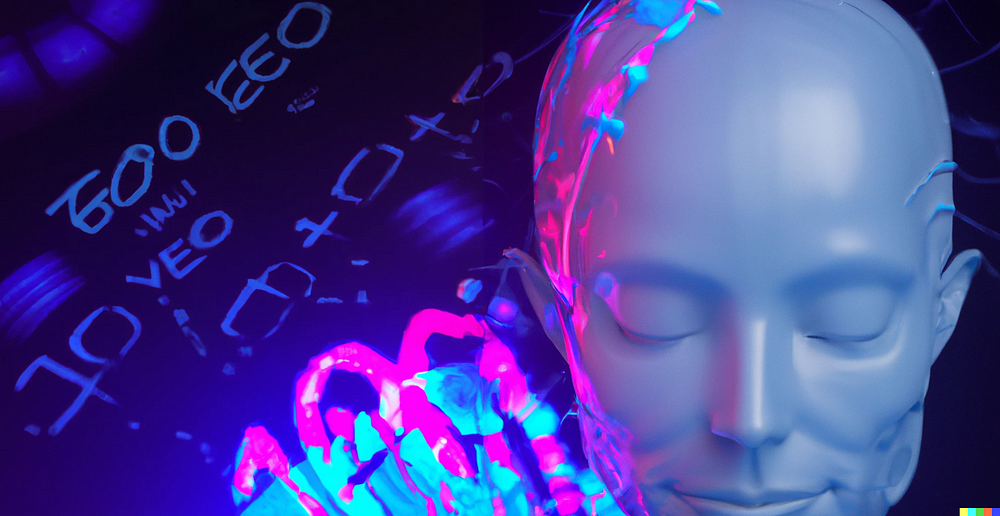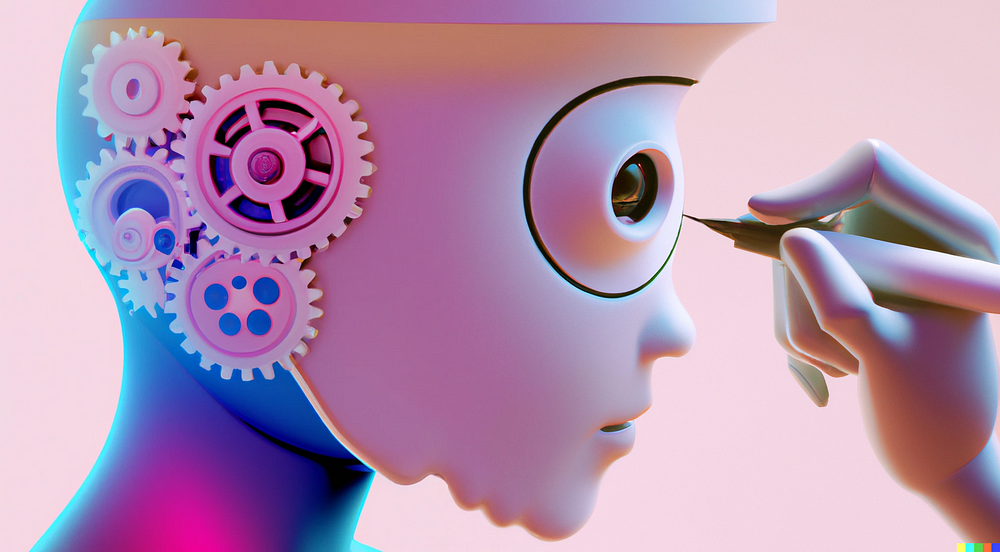The rise of AI will impact everyone. But in what way can UX designers use AI to their benefit? And how do we design AI systems?

The rise of AI is creating a lot of buzz in almost every modern sector. While it remains unclear what we can expect from AI for designers, there have been recent developments that signify that something huge is going to happen.
We may see some groundbreaking development in the way we handle interactions. Digital humans are becoming more present on the internet, and may revolutionize how we interact with the world around us.
Our creativity can also expect a huge boost from AI. We might be able to use AI to quickly visualize our ideas in the near future. The growing development around OpenAI’s Dalle2 have proven that computer-aided creativity can benefit anyone.
Besides new interactions and democratized creativity, in what way is AI going to impact the workflow of UX researchers? In this article I will explore how AI is going to impact the field of UX research.
Automate UX research
The development of digital humans, AI-led bots, can become a game changer for UX researchers. The incredible fidelity of these human-like AI algorithms could be used for AI-led user research.
How I see this happening are human-like bots leading user research as if it were a researcher asking questions. The incredible scalability and multi-lingual support would be great tools for UX researchers.
A UX researcher can then focus on asking the questions, and not doing the research. A researcher can give questions to the AI, who then asks a large sample size these questions. The variety and quantity of data would be far superior to what we design with nowadays.
Efficiently analyze big data
Humans are generally good in recognizing patterns, but only to a certain degree. If we handle big sets of data we easily lose focus. That is where AI can lend us a hand. We can use AI to leverage huge quantities of user-data to find patterns among millions of insights.
I am building my own tool for quick UX research synthesis, Qanda. With Qanda you can easily transcribe and analyze your interviews with AI-generated insights. Such tools will and are already impacting our practices as UX designers quickly.
“Using AI means that designers have access to far more information and can design much more powerful products — AI is playing an ever-bigger role in molding the UX of products and services.” — WeAreDevelopers
Leveraging big data can be difficult, but not using AI. Imagine being able to get user insights out of all tweets on the internet, and the amazing insights you might get from such an analysis. We would not be limited to our own human-scale, but can use data on a far bigger scale.
Quick idea visualizations
AI could also function as a quick way to visualize ideas. Through simply describing in words we can quickly turn ideas into a visual representation, and we all know that visual information is superior to anything else.

A visual I made using DALLE2 for my article on AI replacing creatives
With the new DALLE2, which is now open to anyone to try, we can already see such tools empowering a wider audience than just creatives. We might see ideas and concepts from unexpected corners of society.
But also in our daily business as UX designers we can see these tools coming in handy. What if I just put in a couple of words and an AI creates a wireframe for me? Or I draw something small and it automatically generates a full UX design? Or maybe convert it to code directly?
I think we can then shift our focus from the repetitiveness of our daily tasks, and focus on the actual designing. We should not view this as AI taking over our jobs, but rather complement it. I feel that there is a huge opportunity here and that we need to grab it.
How to design with AI
How exciting AI might be, there are some things we should be careful about. We should think, especially as designers, what the implications of our designs will be on a large scale. We should think about the effects of AI in our designs, as well as the larger implications on society.
“Artificial Intelligence shapes how we think, feel and behave. It drives the decisions that define our future.
We have the responsibility to use this potential for humane technology. Building an AI based on our diverse values and needs requires thoughtful design.” — Website UX of AI
A great initiative talking about this is UX of AI. The website drafts some pretty interesting guidelines for any UX researcher. I will briefly mention these here:
Start with the user. Some designs might not need AI at all. Start with the user experience and think about how AI might help improve that experience. Figure out the added value of AI. You might even find that some solutions do not even need AI in the first place.
Set the right expectations. Designers tend to use AI as a magic potion that can solve any problem. That is simply not true. We can not hide behind AI as an all-problem solver, but we should rather understand its capabilities and limitations. By understanding the different kind of algorithms we can design purposefully and use AI in our designs without sounding like an idiot to developers.
Explain the results. It should be clear how the algorithm produces the output. It may not always be clear, especially because of the ‘black box’ property of some algorithms. It is important to then explain how the data is being used and what the user can expect.
Communicate your confidence. Not all AI functions on the same ‘fidelity’ or quality. It is important to communicate that quality to the user, so that they can decide on the perceived credibility of the resulting output.
Degrade gracefully. It is important to indicate wrong or less credible answers by altering your visual design or layout. Do not be afraid to let the user know you do know have an answer.
Know what to not automate. Not everything should be automated. AI might be a great automation tool in some fields, but some things should not be left for AI to decide. It is better to know when to stop implementing AI and when to use it for the good.
Keep the user in control. Again, AI might be suited for some situations and function as an extension of the users abilities. If the user is using AI, let them be in control. I will touch upon this in an upcoming article about the contestability of AI. Users should always be able to intervene in or ignore the output of any AI powered system.
Build trust over time. New AI systems might require sensitive data to function correctly. Think about designing AI in such a way that implementation does not require trust from the user — at least not directly. Building trust is the key in these kind of situations and will only happen by building trust over time.
Help your users grow. Your AI will have to follow trends that are ongoing. Not only specific users, but your target group will change over time. You might even see that society as a whole will change and require new balancing of your AI.
Balance predictability and serendipity. Any data will have some kind of bias. It is important to know when this bias can come into play and how to counter the effects of it. For example, the Apple card faced gender discrimination charges, and this was to be expected when being trained with outdated sexist data. It is important to realize that those situations might happen, and how users and your service can react to such a thing.
Escape the personality cult. Your AI should not try to emulate a person, but should rather focus on delivering the promise you give to the user. Do not add any funny personality to your AI. It will only confuse or offset your users.
Forget chatbots. Chatbots are limited to a small box and the availability of data. They can be frustrating and irritating to users. In most UX design situations, the use of a simple form might be enough. I think we should wait until digital humans become more developed to actually redesign real-time human-machine interfaces with AI.
Prototype with real data and fake AI. Any good product should be tested first. By using simple Wizard-of-Oz prototyping practices the user can experience the intentional AI firsthand. You might learn a few important insights from these tests which will save you a lot of headache down the line!
Work with everyone. AI has an impact on everyone and everything around us. It is important to explore the value chains and the possible influences that your AI might have on the world around us. Talk and listen to everyone. Realize that you are impacting everyone is an important realization for any designer working with UX design.
Share your process and intentions. Not only should your AI be transparent, but you as the designer should clearly communicate for what purpose data is used. You should be considerate about the use of data especially when designing with AI. Consider opens-sourcing the AI of critical systems.
Avoid collecting user data. As with any data, but again especially in the case of AI, be mindful of why you would need user data. Users are the owner of their own data, and they trust you with it. Collecting user data without any purpose is not only ethically wrong but can lead you down some unnecessary legal fights.
AI should not be scary
AI is going to massively impact our daily practices as UX designers. Our research and design methods could be revolutionized, and we might see rapid changes in the coming years.
Designing with AI is going to be the next challenge. What if it becomes normal to use AI? Do we designers all really know how to handle these powerful tools?
I think that we should consider AI as just another technology, but one that can be used very badly or the right way. We should at least try to understand the basics of AI and the implications it has on our users and society as a whole.

